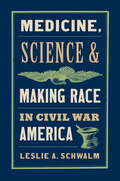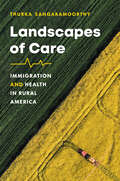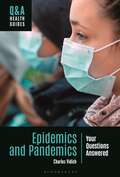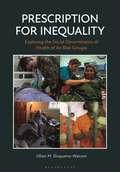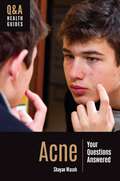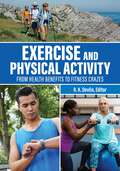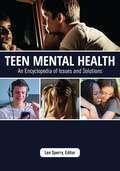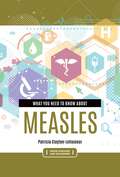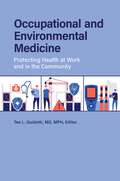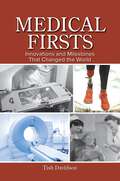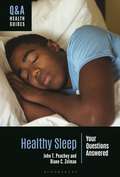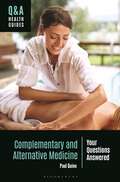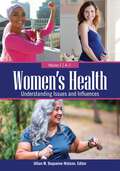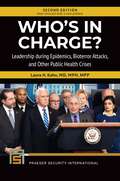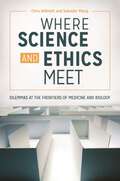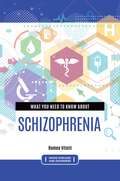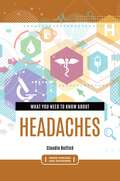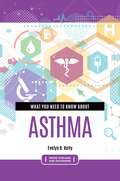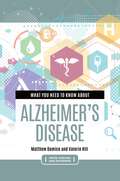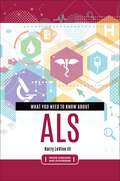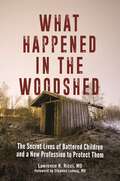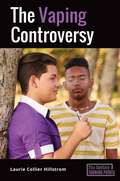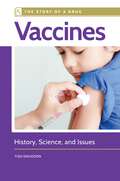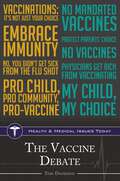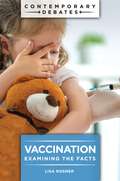- Table View
- List View
Medicine, Science, and Making Race in Civil War America
by Leslie A. SchwalmThis social and cultural history of Civil War medicine and science sheds important light on the question of why and how anti-Black racism survived the destruction of slavery. During the war, white Northerners promoted ideas about Black inferiority under the guise of medical and scientific authority. In particular, the Sanitary Commission and Army medical personnel conducted wartime research aimed at proving Black medical and biological inferiority. They not only subjected Black soldiers and refugees from slavery to substandard health care but also scrutinized them as objects of study. This mistreatment of Black soldiers and civilians extended after life to include dissection, dismemberment, and disposal of the Black war dead in unmarked or mass graves and medical waste pits. Simultaneously, white medical and scientific investigators enhanced their professional standing by establishing their authority on the science of racial difference and hierarchy. Drawing on archives of the U.S. Sanitary Commission, recollections of Civil War soldiers and medical workers, and testimonies from Black Americans, Leslie A. Schwalm exposes the racist ideas and practices that shaped wartime medicine and science. Painstakingly researched and accessibly written, this book helps readers understand the persistence of anti-Black racism and health disparities during and after the war.
Landscapes of Care: Immigration and Health in Rural America (Studies in Social Medicine)
by Thurka SangaramoorthyThis insightful work on rural health in the United States examines the ways immigrants, mainly from Latin America and the Caribbean, navigate the health care system in the United States. Since 1990, immigration to the United States has risen sharply, and rural areas have seen the highest increases. Thurka Sangaramoorthy reveals that that the corporatization of health care delivery and immigration policies are deeply connected in rural America. Drawing from fieldwork that centers on Maryland's sparsely populated Eastern Shore, Sangaramoorthy shows how longstanding issues of precarity among rural health systems along with the exclusionary logics of immigration have mutually fashioned a "landscape of care" in which shared conditions of physical suffering and emotional anxiety among immigrants and rural residents generate powerful forms of regional vitality and social inclusion. Sangaramoorthy connects the Eastern Shore and its immigrant populations to many other places around the world that are struggling with the challenges of global migration, rural precarity, and health governance. Her extensive ethnographic and policy research shows the personal stories behind health inequity data and helps to give readers a human entry point into the enormous challenges of immigration and rural health.
Epidemics and Pandemics: Your Questions Answered (Q&A Health Guides)
by Charles VidichIn the wake of COVID, it's more important than ever to understand epidemics-how they emerge and what we can do to fight back.Part of Bloomsbury's Q&A Health Guides series, this book takes a balanced approach, offering a blend of both epidemiological science and practical suggestions grounded in that science. The volume's 47 questions begin with the basics, including which diseases are most likely to become epidemics, which have historically been the deadliest, and how factors such as climate change will affect the emergence of future pandemics. Next, the book answers readers' questions regarding how epidemics spread and how strategies such as disease reporting, quarantine, and vaccine development can help combat them. Readers will also find questions offering guidance on how to protect yourself during a widespread disease event, including which information sources to trust and how personal choices can influence exposure risk. The final section of questions examines epidemics' far-reaching impacts on everything from mental health to economic prosperity.Augmenting the main text, a collection of 5 case studies illustrate key concepts and issues through relatable stories and insightful recommendations. The common misconceptions section at the beginning of the volume dispels 5 long-standing myths about epidemics and pandemics (the influence of which could be seen throughout the COVID-19 crisis), directing readers to additional information in the text. The glossary defines terms that may be unfamiliar to readers, while the directory of resources curates a list of the most useful books, websites, and other materials. Finally, whether they're looking for more information about this subject or any other health-related topic, readers can turn to the Guide to Health Literacy section for practical tools and strategies for finding, evaluating, and using credible sources of health information both on and off the Internet.
Prescription for Inequality: Exploring the Social Determinants of Health of At-Risk Groups
by Jillian M. Duquaine-WatsonThis book explores how social determinants of health (SDH) impact the health of a variety of marginalized demographic groups in the United States. Chapters focus on the 13 groups that research demonstrates are most disadvantaged by SDH and, consequently, who suffer the most from ongoing health disparities in America. This includes Black and Hispanic individuals, the LGBTQIA+ community, women, the elderly, people with disabilities, veterans, and those living in rural areas, among others.Chapters follow a standardized format that makes it easy for readers to focus in on aspects of the subject that are of greatest interest. Each profile begins with a snapshot of that group's current state of health, including the biggest medical concerns and how other determinants of health may play a role. Next, each chapter takes an in-depth look at the four components of SDH: economic factors, educational access and quality, healthcare access and quality, and living environment and social context. Unique problems and possible solutions are explored within each of these four sections. An end-of-volume bibliography and further readings list points readers who wish to continue their investigation of the topic toward additional information.Relying on an interdisciplinary framework, the book incorporates research from diverse fields including public health, feminist theory, critical studies of race and ethnicity, poverty studies, disability studies, aging studies, cultural competence, legal studies, and global health. In recognition of the reality that health disparities are the result of a complex interplay of forces and structural factors that permeate American culture, analysis extends beyond health and health care to include a broad range of interrelated social, political, economic, and educational components.
Acne: Your Questions Answered (Q&A Health Guides)
by Shayan WasehThis book addresses readers' most pressing questions and concerns about acne, including its causes, effects on the skin, and impact on self-esteem. It provides guidance and resources for anyone struggling with acne, including information about when to see a dermatologist.Pimples. Blemishes. Spots. Zits. Whatever you call it, acne is something that almost everyone will have to deal with at least once in their life. But what exactly is acne, and how do the various types of it differ? What role do hormones, diet, and other lifestyle factors play in causing it? How can it be prevented and effectively treated at home, and when is it a good idea to see a health-care professional? How can we stop acne from taking a toll on our skin and our self-confidence?Books in Greenwood&’s Q&A Health Guides series follow a reader-friendly question-and-answer format that anticipates readerS&Rsquo; needs and concerns. Prevalent myths and misconceptions are identified and dispelled, and a collection of case studies illustrates key concepts and issues through relatable stories and insightful recommendations. Each book also includes a section on health literacy, equipping teens and young adults with practical tools and strategies for finding, evaluating, and using credible sources of health information both on and off the internet—important skills that contribute to a lifetime of healthy decision-making.
Exercise and Physical Activity: From Health Benefits to Fitness Crazes
by R. K. DevlinThis encyclopedia explores exercise and physical activity from a variety of angles, including anatomy and exercise science, health benefits and risks, the wide array of sports and recreational activities available, and the sociocultural context of physical fitness.Exercise and Physical Activity: From Health Benefits to Fitness Crazes is a one-volume encyclopedia featuring more than 200 entries that cover a multitude of exercise-related topics. Content is divided across five broad themes: anatomy, exercise science, sports and activities, health benefits and risks, and exercise and society.The anatomy theme includes entries on all the major skeletal muscle groups and associated connective tissues. Within the exercise science theme, entries focus on topics within the fields of physiology, kinesiology, and sports psychology. Profiles of more than 70 sports and recreational activities are included. Entries under the theme of health benefits and risks explore the effects of exercise on many of the body's physiological processes and related systems, as well as specific sports-related injuries. Exercise and society entries profile influential individuals and organizations, as well as fitness trends. Together, these themes support a holistic understanding of exercise, encompassing both the theoretical and the practical.
Teen Mental Health: An Encyclopedia of Issues and Solutions
by Len SperryThis encyclopedia provides a concise introduction to the mental health topics of greatest concern to adolescents. It offers young readers the information they need to better understand mental disorders and the importance of psychological well-being.Addressing mental illness and prioritizing psychological well-being are important at any age, but the teen years present unique challenges. Hormonal changes, peer pressure, and the demands of school and a busy social life combined with many other factors put adolescents at high risk for mental health problems. Certain disorders, such as depression and anxiety, are particularly prevalent in this age group, as are risky behaviors like substance abuse, self-harm, and distracted driving. Today's teens also face uniquely modern threats to their psychological well-being, such as Internet addiction and social media–induced fear of missing out (FOMO). Yet there are also ample opportunities for adolescents to strengthen their mental health and resiliency through such practices as meditation, activism, and youth leadership.Teen Mental Health: An Encyclopedia of Issues and Solutions is a ready-reference guide to the mental health topics that most affect the lives of American teens in the 21st century. Entries are accessibly written and feature extensive cross-referencing and helpful further reading lists. This volume also offers a collection of recommended resources, including a number of hotlines for teens in crisis.
What You Need to Know about Measles (Inside Diseases and Disorders)
by Patricia Clayton-LeVasseurAlthough measles is a preventable disease, today cases are on the rise in the United States because of falling vaccination rates. This book provides a broad introduction to this once widespread and still potentially very dangerous viral infection.Measles is a highly contagious viral infection that can cause serious, even life-threatening, complications. Although the MMR vaccine is effective at preventing measles, the rise of anti-vaccination sentiment in the United States has many experts concerned that measles may once again become a significant public health threat.What You Need to Know about Measles is part of Greenwood's Inside Diseases and Disorders series. This series profiles a variety of physical and psychological conditions, distilling and consolidating vast collections of scientific knowledge into concise, readable volumes. A list of "top 10" essential questions begins each book, providing quick-access answers to readers' most pressing concerns. The text follows a standardized, easy-to-navigate structure, with each chapter exploring a particular facet of the topic. In addition to covering such basics as causes, signs and symptoms, diagnosis, and treatment options, books in this series delve into issues that are less commonly addressed but still critically important, such as effects on loved ones and caregivers. Case illustrations highlight key themes discussed in the book and are accompanied by insightful analyses and recommendations.
Occupational and Environmental Medicine: Protecting Health at Work and in the Community
by Tee L. GuidottiProviding a concise introduction to the field of occupational and environmental medicine, this book delves into what it does, how it protects workers, how it benefits employers, and how it is developing as an important field in health protection.This book shines a light on an important but little-appreciated corner of medicine where health, technology, the environment, and the economy come together to have a real impact on people and society. The text serves as one of the few entry points into the world of occupational and environmental health protection for readers interested in learning more about it and what it can do for them.Readers will be introduced to such topics as the history of occupational and environmental medicine (OEM), schools of thought associated with OEM, the relationship of OEM to neighboring fields of study, and profiles of OEM practitioners. This guide emphasizes the rich potential for environmental medicine to contribute to sustainability, public health, and community health protection, making it an essential resource for anyone interested or involved in these sectors.
Medical Firsts: Innovations and Milestones That Changed the World
by Tish DavidsonProfiling 60 medical innovations and milestones from the 11th through 21st centuries, this book highlights the people and stories behind these key moments while also exploring their historical context and enduring legacy.Medical Firsts: Innovations and Milestones That Changed the World brings together a carefully curated collection of turning points in the history of medicine over the last millennium. These firsts are drawn from a wide array of medical fields, from surgery to genetics, dentistry, and psychiatry. Firsts are arranged chronologically, but a thematic listing has also been included to allow readers to focus in on particular subject areas, such as trailblazing individuals, groundbreaking drugs and treatments, pioneering diagnostic tools, and life-saving medical procedures. Each entry begins with a description of how the first came to be, followed by discussion of the historical context in which it emerged and its continued impact on the world of medicine. Sources for further information are provided at the end of each entry and serve as a gateway to further study.We take many modern medical devices and techniques for granted, but everything from hypodermic needles and baby incubators to organ transplants, antibiotics, and hearing aids began simply as ideas in someone's mind. And while such concepts as formal medical education, methodical clinical trials, and universal healthcare may seem commonplace today, this wasn't always the case. In some cases, milestones centered around key people and institutions rather than technologies or ideas. Do you know who the first woman to win the Nobel Prize in Physiology or Medicine was, or where the oldest medical school still in existence resides? Medical history comes to life in this captivating volume.
Healthy Sleep: Your Questions Answered (Q&A Health Guides)
by John T. Peachey Diane C. ZelmanWe all know how important sleep is, but many of us struggle to consistently get enough high-quality rest. This book answers readers' sleep-related questions and offers guidance for a better night's slumber.Part of Bloomsbury's Q&A Health Guides series, this book aims to educate teens and young adults about the importance of sleep through an engaging question-and-answer format. The book's 44 questions cover the basics of sleep and dreaming, the connection between sleep and health, sleep problems and disorders, and how to improve sleep:- Why exactly is sleep so important?- How does not getting enough impact physical wellbeing, academic performance, and interactions with others?- How do you know if you have a sleep disorder?- Can caffeine and power naps really make up for poor sleep habits?The text strikes a balance between theory and practice, offering both clear explanations of foundational concepts in sleep science and useful suggestions that readers can implement in their own lives.Augmenting the main text, a collection of 5 case studies illustrate key concepts and issues through relatable stories and insightful recommendations. The "Common Misconceptions" section at the beginning of the volume dispels 5 long-standing myths about sleep, directing readers to additional information in the text. The glossary defines terms that may be unfamiliar to readers, while a directory of resources curates a list of the most useful sleep-related books, websites, and other materials. Finally, whether they're looking for more information about sleep or any other health-related topic, readers can turn to the "Guide to Health Literacy" section for practical tools and strategies for finding, evaluating, and using credible sources of health information both on and off the Internet.
Complementary and Alternative Medicine: Your Questions Answered (Q&A Health Guides)
by Paul QuinnExplore the many forms of complementary and alternative medicine (CAM) practiced today and discover their histories, guiding principles, purported benefits, and potential risks. Part of Bloomsbury's Q&A Health Guides series, this book examines a wide variety of forms of CAM popular in the 21st century. The volume's 48 questions begin with 10 that address foundational topics such as who uses CAM, how CAM has been studied and regulated, and how to gauge a particular treatment's safety and efficacy for yourself. The remaining 38 questions cover alternative medical systems and complementary treatments, including mind-body interventions, biologically based therapies, manipulation- and body-based methods, and energy therapies. Each answer utilizes a standardized format that examines a treatment's history, how it's practiced, the scientific community's view, potential benefits and risks, and special considerations. The text takes an unbiased approach, balancing respect for individuals' beliefs with the rigor of modern science.Augmenting the main text, a collection of 5 case studies illustrate key concepts and issues through relatable stories and insightful recommendations. The Common Misconceptions section at the beginning of the volume dispels 5 long-standing myths about CAM, directing readers to additional information in the text. The Glossary defines terms that may be unfamiliar to readers, while the Directory of Resources curates a list of the most useful books, websites, and other materials. Finally, whether they're looking for more information about this subject or any other health-related topic, readers can turn to the Guide to Health Literacy section for practical tools and strategies for finding, evaluating, and using credible sources of health information both on and off the Internet.
Women's Health [2 volumes] [2 volumes]: [2 volumes]
by Jillian M. Duquaine-WatsonThis interdisciplinary project provides an informative, accessible, and comprehensive introduction to women's health. Emphasizing the perspectives of diverse groups of women, it addresses various biological, economic, social, environmental, and political factors that influence women's health and well-being.Women are more likely than men to experience mood disorders, certain types of cancer, Alzheimer's disease, stroke, arthritis, lupus, and celiac disease. In addition, women face significantly more barriers to health care than men due to a variety of social, economic, political, and environmental factors, including inequality, poverty, legislation, and pollution. Despite this, the field of women's and girls' health remains both understudied and underfunded.Women's Health: Understanding Issues and Influences explores important topics in the field of women's health in the early 21st century, offering readers a comprehensive and informative yet accessible introduction to women's health in the United States. While some topics are unique to women's health, others illustrate how women's health and women's experiences within the U.S. health care system are different from men's, as well as how certain health issues impact women differently than men. Entries have been crafted by a diverse team of contributors with wide-ranging expertise, and each entry features a collection of further readings and cross references to other relevant entries.
Who's in Charge?: Leadership during Epidemics, Bioterror Attacks, and Other Public Health Crises (Praeger Security International)
by Laura H. KahnWith a new preface assessing leadership responses to the coronavirus pandemic, this text explores leadership problems that can develop during such public health crises as the 2001 anthrax attacks, 2003 SARS epidemic, and Mad Cow Disease epidemic of the 1980s–1990s.A threat to public health, such as a rampaging virus, is no time for a muddled chain of command and contradictory decision-making. Who's In Charge? Leadership during Epidemics, Bioterror Attacks, and Other Public Health Crises, re-issued with a new preface assessing leadership during the COVID-19 outbreak, explores the crucial relationships among political leaders, public health officials, and journalists to see why leadership confusion develops. As the problematic response to COVID-19 has once again shown, the reluctance of politicians to risk alarm can run counter to the public health need to prepare for worse cases.Many leaders will seek high visibility during a public health crisis, but politicians are not medical experts, and the more they speak, the more they risk disseminating harmful information. How to achieve the right balance is the essence of this book. Beginning by looking at the overarching issues of leadership and public health administration, it then examines in depth five emergencies: the 2001 anthrax attacks, the 1993 cryptosporidium outbreaks, the 2003 SARS outbreak, the 2001 foot-and-mouth disease crisis, and the battle against Mad Cow Disease.
Where Science and Ethics Meet: Dilemmas at the Frontiers of Medicine and Biology
by Chris Willmott Salvador MacipThrough engaging case studies and clear explanations of the underlying science, this book makes the social impacts and ethical consequences of recent advances in biomedicine understandable for general readers.Recent biomedical discoveries promise considerable improvement in the quality of human life, but they also hold the potential to permanently alter society. Are the anticipated benefits worth the price we would have to pay for them? In Where Science and Ethics Meet: Dilemmas at the Frontiers of Medicine and Biology, a biochemist and a biomedical researcher who are highly experienced in explaining ethics for lay audiences present the most innovative advances in biomedicine and enable readers to develop their own opinions about the ethical and social consequences these technologies will bring. Each controversial topic in modern medicine and ethics is introduced through a hypothetical case study that highlights thorny ethical issues before explaining the key aspects of the science and technology involved and addressing the associated ethical considerations in detail. The interdisciplinary treatment of the topics makes the book relevant to students of science, medicine, ethics, law, and sociology as well as health care professionals.
What You Need to Know about Schizophrenia (Inside Diseases and Disorders)
by Romeo VitelliAlthough often depicted as aggressive and unpredictable in movies, people with schizophrenia are actually far more likely to be the victims of violence than perpetrators of it. This book sheds light on the realities of this often misunderstood mental illness.Schizophrenia is a mental disorder characterized by delusions, hallucinations, and disordered thoughts and behaviors. Although schizophrenia requires lifelong treatment, early intervention can help individuals effectively manage their symptoms. Even so, it can be a challenging condition to navigate for both the patient and their loved ones.What You Need to Know about Schizophrenia is part of Greenwood's Inside Diseases and Disorders series. This series profiles a variety of physical and psychological conditions, distilling and consolidating vast collections of scientific knowledge into concise, readable volumes. A list of "top 10" essential questions begins each book, providing quick-access answers to readers' most pressing concerns. The text follows a standardized, easy-to-navigate structure, with each chapter exploring a particular facet of the topic. In addition to covering such basics as causes, signs and symptoms, diagnosis, and treatment options, books in this series delve into issues that are less commonly addressed but still critically important, such as effects on loved ones and caregivers. Case illustrations highlight key themes discussed in the book and are accompanied by insightful analyses and recommendations.
What You Need to Know about Headaches (Inside Diseases and Disorders)
by Claudio ButticèThere are numerous types of headaches, each with a unique cause, pain profile, and set of treatment options. This book offers readers a broad introduction to this common, yet often misunderstood, group of conditions.What exactly is going on in your body during a headache? How can they be prevented or managed? How can you tell if your splitting headache is actually a brain tumor? This book provides the answers to these and many other questions.What You Need to Know about Headaches is the latest volume in Greenwood's Inside Diseases and Disorders series. This series profiles a variety of physical and psychological conditions, distilling and consolidating vast collections of scientific knowledge into concise, readable volumes. A list of "top 10" essential questions begins each book, providing quick-access answers to readers' most pressing concerns. The text follows a standardized, easy-to-navigate structure, with each chapter exploring a particular facet of the topic. In addition to covering such basics as causes, signs and symptoms, diagnosis, and treatment options, books in this series delve into issues that are less commonly addressed but still critically important, such as effects on loved ones and caregivers. Case illustrations highlight key themes discussed in the book and are accompanied by insightful analyses and recommendations.
What You Need to Know about Asthma (Inside Diseases and Disorders)
by Evelyn B. KellyWhile some individuals with asthma consider the condition only a minor nuisance, for others it significantly interferes with daily activities and may even be life-threatening. This book offers readers a broad introduction to this common respiratory issue.Asthma is a respiratory condition marked by spasms, swelling, and excess mucus production in the bronchial passages of the lungs. This triggers coughing, wheezing, chest tightness, and shortness of breath. While asthma can usually be managed with medications and avoidance of certain triggers, it's a serious—potentially deadly—chronic disease.What You Need to Know about Asthma is part of Greenwood's Inside Diseases and Disorders series. This series profiles a variety of physical and psychological conditions, distilling and consolidating vast collections of scientific knowledge into concise, readable volumes. A list of "top 10" essential questions begins each book, providing quick-access answers to readers' most pressing concerns. The text follows a standardized, easy-to-navigate structure, with each chapter exploring a particular facet of the topic. In addition to covering such basics as causes, signs and symptoms, diagnosis, and treatment options, books in this series delve into issues that are less commonly addressed but still critically important, such as effects on loved ones and caregivers. Case illustrations highlight key themes discussed in the book and are accompanied by insightful analyses and recommendations.
What You Need to Know about Alzheimer's Disease (Inside Diseases and Disorders)
by Matthew Domico Valerie HillThis book provides readers with the information they need to better understand Alzheimer's disease. Written in easy-to-understand language, it is aimed at those who may have a parent, grandparent, or other loved one struggling with this condition.Alzheimer's disease is a neurodegenerative disorder that causes problems with thinking, memory, and behavior. Such symptoms as memory loss usually develop slowly but get worse over time, eventually becoming severe enough to interfere with daily activities and bodily functions.What You Need to Know about Alzheimer's Disease is part of Greenwood's Inside Diseases and Disorders series. This series profiles a variety of physical and psychological conditions, distilling and consolidating vast collections of scientific knowledge into concise, readable volumes. A list of "Top 10" essential questions begins each book, providing quick-access answers to readers' most pressing concerns. The text follows a standardized, easily navigable structure, with each chapter exploring a particular facet of the topic. In addition to covering such basics as causes, signs and symptoms, diagnosis, and treatment options, books in this series delve into issues that are less commonly addressed but still critically important, such as effects on loved ones and caregivers. Case illustrations highlight key themes discussed in the book and are accompanied by insightful analyses and recommendations.
What You Need to Know about ALS (Inside Diseases and Disorders)
by Harry LeVine IIIThis book offers an accessibly written introduction to ALS, focusing on the topics that matter most to anyone whose life has been affected—directly or indirectly—by this condition.Amyotrophic lateral sclerosis (ALS) or Lou Gehrig's disease, is a neurodegenerative disease that affects the motor neurons that drive voluntary movement. Those diagnosed with ALS experience difficulty moving and speaking and, as the condition worsens, difficulty swallowing and breathing. Beyond this definition, however, what do those affected by ALS need to know?What You Need to Know about ALS is a part of Greenwood's Inside Diseases and Disorders series. This series profiles a variety of physical and psychological conditions, and distills vast collections of scientific knowledge into concise, readable volumes. A list of "Top 10" essential questions begins each book, providing quick-access answers to readers' concerns. The text follows a standardized structure, with each chapter exploring a particular facet of the topic. In addition to covering causes, signs and symptoms, diagnosis, and treatment options, books in this series delve into issues that are less commonly addressed but still critical to understand, such as effects on loved ones and caregivers. Case illustrations highlight key themes discussed in the book and are accompanied by insightful analyses and recommendations.
What Happened in the Woodshed: The Secret Lives of Battered Children and a New Profession to Protect Them
by Lawrence R. M.D.A riveting exposé of child abuse in America and how the newest breed of pediatricians determines what happened, why, and at whose hands.Although more than one million children are abused each year in the United States, child abuse often remains a secret to family members, professionals, and politicians who neither see nor understand it. Child abuse pediatricians are the newest breed of pediatricians, specialized in exposing abuse. With detective-like acumen, child abuse pediatricians deduce through careful medical analysis who has abused and who has been abused. Describing the most compelling cases among the thousands that they have evaluated, author Lawrence Ricci reveals the trauma, pain, disability, and sometimes death that abused children experience at the hands of trusted adults.This gripping look at the dark side of American families is about good parents and poor ones, perpetrators and victims, and collateral victims such as innocent family members. It is also about the professionals who have made it their career to expose child abuse and to treat children who have suffered from it. The conclusion calls for systematic changes that could help to stem the tide of child abuse.
The Vaping Controversy (21st-Century Turning Points)
by Laurie Collier HillstromThis work provides an evenhanded and authoritative overview of vaping and its impact on American culture and public health, especially among younger Americans.The 21st Century Turning Points series is a one-stop resource for understanding the people and events changing America today. This volume is devoted to the rapid rise of vaping across the nation, especially among young people. This trend has prompted fierce debate in communities across the country, with some people heralding "e-cigarettes" and other vaping devices as valuable smoking cessation tools and others condemning them for being unhealthy in their own right—and a gateway to future cigarette consumption. The Vaping Controversy describes the key events and people that provided the foundation for the rise of e-cigarettes and vaping, from governmental and medical efforts to reduce traditional cigarette smoking to the emergence and rapid spread of an entire industry devoted to selling vaping devices and accessories. This volume also explores how vaping has influenced youth culture and high school life, its impact on "old school" tobacco companies, and the increasingly visible partisan divide in attitudes about the public health impact of vaping.
Vaccines: History, Science, and Issues (The Story of a Drug)
by Tish DavidsonProviding scientifically accurate, detailed, and accessible information to students and general readers, this book presents the history of vaccination; describes the administration, manufacturing, and regulation of vaccines in the United States; and explains the most recent scientific findings about vaccination while addressing concerns of those who oppose immunization.What is a vaccine and how does it work? How are vaccines made? Who discovered vaccines? What diseases do vaccines prevent, are these vaccines effective, and are they safe? Presenting comprehensive information on a topic that remains the focus of considerable controversy, Vaccines: History, Science, and Issues provides readers with a single-volume examination of vaccines and their history, production, uses, and limitations. Written in language that avoids intimidating medical jargon, this latest addition to Greenwood's Story of a Drug series looks at different types of vaccines and documents the value of vaccination to society. It explains the process of developing a vaccine, the testing required before it can be distributed to the public, and the challenges that arise in manufacturing and distribution, along with potential solutions to some of these problems. Readers will gain insight into vaccination-related topics such as the legal issues surrounding mandatory vaccination, the relationship between vaccines and adverse events, and the government's role in adjudicating claims of damage. The book also includes international recommendations from the World Health Organization and information on vaccines that are available and used outside the United States.
The Vaccine Debate (Health and Medical Issues Today)
by Tish DavidsonProviding accurate, accessible information on vaccines and the controversies that surround them, this book outlines the history of vaccine regulation and interactions between vaccines and the immune system, and thoughtfully considers each vaccine debate.A part of Greenwood's Health and Medical Issues Today series, The Vaccine Debate provides a straightforward introduction to the interaction between vaccines and the immune system. The book documents the rise of the anti-vaccination movement, provides reasons for its prominence today, and explains the effects of vaccine refusal on public health. It also addresses concerns about the role of government in regulating vaccine production and administration, along with questions about vaccine safety.Additionally, a majority of the book examines in detail seven major vaccine controversies and mainstream medical positions on them. These controversies are given individual attention, with questions at the end of each to encourage critical thinking about such topics as the effectiveness of vaccines in protecting public health and whether vaccinations should be mandatory for public school attendance.
Vaccination: Examining the Facts (Contemporary Debates)
by Lisa RosnerEveryone has opinions about vaccines, but what are the facts? This resource provides clear, unbiased, and up-to-date information on vaccination, which protects the world's populations not only from pandemics like COVID-19 but other dangerous diseases as well.Each title in the Contemporary Debates series examines the veracity of controversial claims or beliefs surrounding a major political/cultural issue in the United States. They do so to give readers a clear and unbiased understanding of current issues by informing them about falsehoods, half-truths, and misconceptions—and confirming the factual validity of other assertions—that have gained traction in America's political and cultural discourse.This latest addition to the series is the first reference work on vaccines written through the lens of the COVID-19 pandemic. It asks—and answers—questions raised by the pandemic, such as how vaccines work, what causes side effects, and how COVID-19 vaccines were developed so quickly. It also addresses broader questions, such as how to protect vaccine supply chains and how to prevent public health issues from being politicized. In addition to correcting or clarifying well-known misinformation and misunderstandings about vaccines (such as false claims that they have been linked to autism), this book also provides up-to-date research on ways to counter disinformation and decrease vaccine hesitancy.
